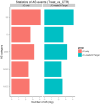Effect of Curcumin on Hepatic mRNA and lncRNA Co-Expression in Heat-Stressed Laying Hens
- PMID: 38791430
- PMCID: PMC11121607
- DOI: 10.3390/ijms25105393
Effect of Curcumin on Hepatic mRNA and lncRNA Co-Expression in Heat-Stressed Laying Hens
Abstract
Heat stress is an important factor affecting poultry production; birds have a range of inflammatory reactions under high-temperature environments. Curcumin has anti-inflammatory and antioxidant effects. The purpose of this experiment was to investigate the effect of dietary curcumin supplementation on the liver transcriptome of laying hens under heat stress conditions. In the animal experiment, a total of 240 Hy-Line brown hens aged 280 days were divided randomly into four different experimental diets with four replicates, and each replicate consisted of 15 hens during a 42-D experiment. The ambient temperature was adjusted to 34 ± 2 °C for 8 h per day, transiting to a range of 22 °C to 28 °C for the remaining 16 h. In the previous study of our lab, it was found that supplemental 150 mg/kg curcumin can improve production performance, antioxidant enzyme activity, and immune function in laying hens under heat stress. To further investigate the regulatory mechanism of curcumin on heat stress-related genes, in total, six samples of three liver tissues from each of 0 mg/kg and 150 mg/kg curcumin test groups were collected for RNA-seq analysis. In the transcriptome analysis, we reported for the first time that the genes related to heat stress of mRNA, such as HSPA8, HSPH1, HSPA2, and DNAJA4, were co-expressed with lncRNA such as XLOC010450, XLOC037987, XLOC053511, XLOC061207, and XLOC100318, and all of these genes are shown to be down-regulated. These findings provide a scientific basis for the possible benefits of dietary curcumin addition in heat-stressed laying hens.
Keywords: RNA-seq; curcumin; heat stress; laying hens; lncRNA; transcriptome analysis.
Conflict of interest statement
The authors declare no conflict of interest.
Figures







References
-
- Kim D.-H., Lee K.-W. An Update on Heat Stress in Laying Hens. World’s Poult. Sci. J. 2023;79:689–712. doi: 10.1080/00439339.2023.2239769. - DOI
MeSH terms
Substances
Grants and funding
LinkOut - more resources
Full Text Sources
Miscellaneous

